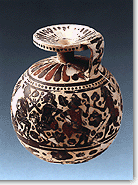Corinthian
Transitional, 625-610 B.C. During this period many elements of the previous one continued, however with signs of a certain schematisation and inanimate repetition becoming apparent.
Early Corinthian, 610-580 B.C. At the same time as the well-known animal friezes, which in this phase are covered with various secondary motifs, mostly rosettes, the large vases -such as the column crater- continued to be decorated with narrative scenes, usually simplified and less detailed.
Middle Corinthian, 580-555 B.C. During this phase the animal bodies were elongated, to cover the friezes more easily, whereas even the rosettes were gradually transformed into simple dots.
Late Corinthian, 555-535 B.C. The Corinthian potters, in order to compete with the Athenians, imitated the shape of the type A amphora and the panel decoration. Some painters produced some interesting representations with the use of added white and red colour. These were the last works that were of considerable note. Whatever followed after 535 B.C., were of little importance -usually small size- works for mainly local consumption. |



















